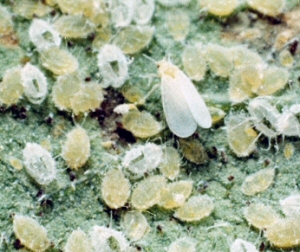Whiteflies
 Hosts
Hosts
Whiteflies are not true flies. They’re more closely related to scales, mealybugs, and aphids. These pests are more commonly associated with plants growing in greenhouses than those growing in homes.
Symptoms

Life Cycle
The whitefly has a complex life history. It undergoes five distinct stages of development. Eggs are laid on the undersides of the leaves, and are at first pale yellow, but turn gray before hatching in 5 to 7 days. The crawler is a small, translucent, mobile stage that actively searches for a feeding site. Within a few days crawlers settle down and begin feeding, soon transforming to the sedentary scale stage. The scale is a highly modified sucking insect, and its outer covering thickens after it feeds giving it added protection. Adult development (pupation) occurs within the scale cover. Four days later, adults emerge. The life cycle takes about 40 days, depending on temperature.
Description
Adult whiteflies are small insects, approximately 1/16th inch (1.5 mm)in length, with
four powdery white wings. When heavily infested plants are disturbed, one may notice
a "cloud" of tiny white insects rising above it. The immature stages (eggs, crawlers,
scales and pupae) are all yellowish and found primarily on the undersides of leaves.
Control: Please contact your local county extension office for current information.

